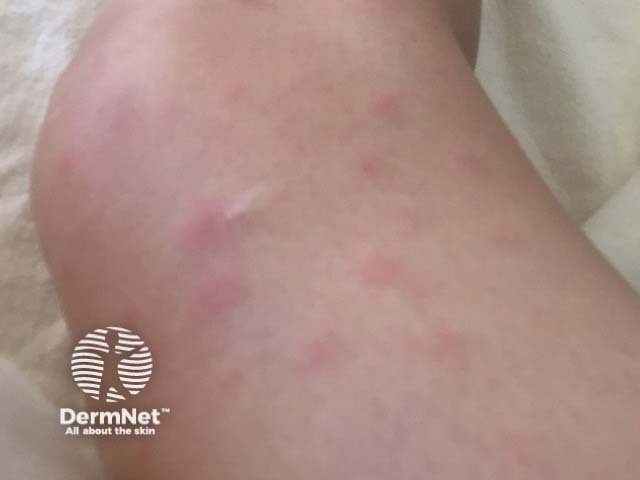Main menu
Common skin conditions

NEWS
Join DermNet PRO
Read more
Quick links
Nodular panniculitis — extra information
Nodular panniculitis
Author: David Ma, 2nd Year Medical Student, University of Alberta, Edmonton, Canada; Chief Editor: Dr Amanda Oakley, Dermatologist, Hamilton, New Zealand, April 2016.
Introduction - panniculitis Introduction Demographics Causes Clinical features Complications Diagnosis Treatment Outlook
What is panniculitis?
Panniculitis is a condition where the fat under the skin becomes inflamed.
What is nodular panniculitis?
Nodular panniculitis is characterised by one or multiple, recurrent, subcutaneous nodules. These commonly arise on the legs but can arise elsewhere on the body. Nodular panniculitis is associated with acute systemic symptoms such as fever, general malaise and abdominal pain. The term 'nodular panniculitis' is used when no specific cause for the panniculitis has been found (such as erythema nodosum or alpha-1-antitrypsin deficiency).
Nodular panniculitis is also referred to as relapsing, febrile, non-suppurative panniculitis. In the past, it was also called Weber Christian disease.
Who gets nodular panniculitis?
Nodular panniculitis is rare. It occurs in males and females of all ages. It most commonly affects young adult women, and it rarely affects young children.
Nodular panniculitis is associated with autoimmune diseases such as Sjögren syndrome, inflammatory bowel disease, systemic lupus erythematosus, and diabetes mellitus.
What causes nodular panniculitis?
The cause of nodular panniculitis is unknown. One hypothesis is that fat may trigger an autoimmune or autoinflammatory granulomatous reaction.
The mechanism of nodular panniculitis is that white blood cells infiltrate and damage the subcutaneous fat, causing necrosis and fibrosis.
What are the clinical features of nodular panniculitis?
The first signs of nodular panniculitis are:
- Fever
- Malaise
- Painful nodules, 1–2 cm in diameter, on both thighs, lower legs and buttocks.
Each nodule regresses after a few weeks. In some cases, the nodules can ulcerate and leak an oily, yellow discharge.

Nodular panniculitis
Complications of nodular panniculitis
Nodular panniculitis can involve visceral organs and cause other symptoms and complications such as:
- Polyarthralgia (sore joints) and polymyalgia (sore muscles)
- Bowel perforation
- Pleural effusion
- Anaemia from bone marrow infiltration
- Vasculitis.
How is nodular panniculitis diagnosed?
Skin biopsy shows a lobular pattern of inflammation with or without vasculitis. Nodular panniculitis is diagnosed when other forms of lobular panniculitis associated with fever have been excluded.
What is the treatment for nodular panniculitis?
There is no single effective therapy. Nodular panniculitis without the involvement of other organs should be treated symptomatically.
- Analgesics such as nonsteroidal anti-inflammatory drugs should be prescribed for pain.
- Dressings should be applied if there are ulcers.
- Systemic corticosteroids such as oral prednisone may be effective in severe nodular panniculitis. The dosage should be tapered after 7–10 days over a period of 4–6 weeks.
Other treatments reported to be of benefit include mycophenolate mofetil, thalidomide, clofazimine, antimalarials such as hydroxychloroquine, antibiotics, dapsone, and immunosuppressive drugs such as azathioprine and ciclosporin.
What is the outlook for nodular panniculitis?
Nodular panniculitis tends to settle down after a few weeks or months. There may be a single episode, or the disease may relapse repeatedly over time.
Involvement of other organs is associated with a high risk of mortality.
References
- Abuzahra F, Kovacs S, Beermann T, Merk HF, Frank J. Treatment of relapsing idiopathic nodular panniculitis with clofazimine. Br J Dermatol. 2005 Mar;152(3):582–3. PubMed.
- Baskan EB, Saricaoglu H, Tunali S, Tolunay S. Effective treatment of relapsing idiopathic nodular panniculitis (Pfeifer-Weber-Christian disease) with mycophenolate mofetil. J Dermatolog Treat. 2003;14:57–60. PubMed.
- Black MM, Cunliffe WJ. Subcutaneous fat. In: Burns T, Breathnach S, Cox N, Griffith C, editors. Rook’s textbook of dermatology. 8th ed. Massachusetts: Blackwell Publishing; 2010. P.46. 13–46.14.
- Bolognia JL, Jorizzo JL, Rapini R, Horn TD, Mascaro JM, Mancini, Salasche SJ, Saurat J, Singl G, editors. Dermatology. London: Mosby; 2003.
- Bukhari I. Idiopathic nodular panniculitis in Niemann-Pick disease. J Eur Acad Dermatol Venereol. 2005 Sep;19(5):600–2. PubMed.
- Iwasaki T, Hamano T, Ogata A, Hashimoto N, Kakishita E. Successful treatment of a patient with febrile, lobular panniculitis (Weber-Christian disease) with oral cyclosporin A: implications for pathogenesis and therapy. Intern Med. 1999;38:612–14. PubMed.
- NORD Rare Disease Database [Internet]. Danbury (CT): National Organization for Rare Disorders, Panniculitis, Idiopathic Nodular; [updated 2007; cited 2016 Jan 18]; [about 3 screens].
- Sharma AK, Sharma PR. Idiopathic lobular panniculitis (Weber Christian disease): A case report. Kathmandu Univ Med J. 2006;4(14):243–245. PubMed.
On DermNet
Other websites
- Weber-Christian Disease — Medscape
